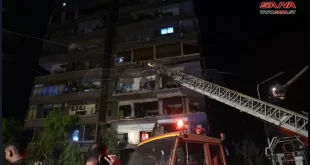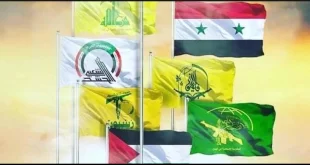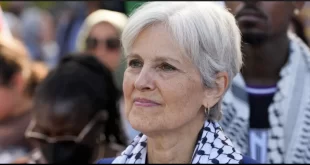Sep 11, 2014, Eva Bartlett, Zero Anthropology
In stark contrast to the sparse coverage of the brutality of ISIS and other terrorist groups in Syria over the past few years, there has recently been substantial coverage of the emergence of ISIS in Iraq and the terrorist acts that this US-backed and funded group has been committing. This surge of media focus on ISIS’ brutality in Iraq and particularly on the recent alleged be-headings of two American journalists is extensively considered, amongst independent political analysts, to be setting the stage for NATO and the Axis-of-Imperialists to “fight terrorism” in Iraq and Syria, aka destroy both countries (note: there are valid doubts as to the legitimacy of the Foley video itself).
Glaringly absent from corporate media accounts of the proxy-war being waged on Syria is the fact that the very same terrorist group, as well as other Western-backed, al-Qaeda aligned terrorist organizations (like al-Nusra and the so-called “Free Syrian Army”), have been terrorizing Syrians for years—beheading them, flogging, crucifying, amputating hands—to name but a few of their crimes against thousands of Syrians.
In a recent interview, scholar and author Zafar Bangash noted Western-complicity in supporting ISIS and other mercenary groups, as well as NATO’s complicity in the destruction of Syria thus far:
“As a member of NATO, obviously Turkey has close liaison with the United States, Britain, France, etc, providing them all kinds of information. A NATO member, that means by extension NATO itself, is involved in financing, supporting, arming, facilitating the transfer, or entry, of these terrorists into Syria.”
Also omitted are the terrorist-insurgents’ near-daily firing of lethal mortars upon civilian areas in Syria. According to political analyst and Damascus resident Mazen al-Akhras, in the three-month period of April, May and June 2014, terrorist-insurgents fired 994 mortars on Damascus and environs, 426 of which were fired in June (see list of locations hit and number of mortars below). On June 3, Election Day in Syria, the terrorist-insurgents fired 151 shells on Damascus, killing 5 and maiming 33 Syrians, Akhras said.
While statistics on the number of Syrians civilians killed and maimed by such mortar attacks are not readily available, a tally from State media news reports for the period of Jun 18, 2014-current (the available reports) reveals at least 48 Syrians were killed (including 10 children) and 358 injured by mortar fire.
The terrorizing car-bombings which were rampant in civilian areas of Homs (now secured by the Syrian Arab Army), and which continue to plague areas in Hama, have received some scant coverage. But the mortars continue (still out of the media spotlight), albeit to a lesser degree than a few months ago thanks to the gains of the Syrian army in areas like Mleiha (Damascus outskirts), where mortar-fire originated, and increasingly in Jobar (Damascus outskirts).
In April and June 2014, I spent a cumulative month in Syria, in various areas of Damascus, with visits to Latakia, Homs, and Ma’aloula. At the time, Damascus was being intensely shelled by mortars, frequently in my vicinity, including just behind the hotel housing the Peace Delegation which I accompanied for the first week (photo). This attack killed three civilians and one Syrian soldier. We saw some of the 60 plus children injured in the April 15 shelling of a school, not an isolated occasion, an attack which also killed one child. Mortars rained down at close-proximity on many occasions in different areas of the Old City where I had then found lodging.

Photograph by Eva Bartlett, 2014.
Prior to and since then, other residential, civilian areas I’ve become familiar with have been incessantly-targeted, and none of those areas can be considered targets for a “revolution”—in other words, neither governmental nor military sites. The terrorist-insurgents are intentionally targeting high-density civilian areas, and often take videos of themselves manufacturing, preparing and firing the mortar shells.
Bab Touma (Thomas Gate), Bab Sharqi (East Gate), and the Shagour area of the Old City have all been repeatedly targeted, as have the commercial Shaalan district—particularly near the Dar al-Salaam school—and other areas of Damascus and environs, including Abasyeen, Dweilaa, Baramkeh, Jaramana, Yarmouk, and Mazzeh. These are areas housing shops, restaurants, homes, schools, hospitals and clinics, hotels, parks, and thus the victims are Syrian civilians, including children.
In June, I spoke with a National Defense Force (NDF) soldier, who explained to me the nature of the mortars being fired on Damascus, the surrounding areas and further afield in Syria. He began with an explanation of his own knowledge of weaponry:
“In Syria, when you are 18, you do mandatory military service (until 2005 it was 2.5 years; in 2011 it was reduced to 18 months). I served in a unit that specialized in rockets. But when they started teaching us about rockets, they had to first teach you the basic science, which is mortars. We began learning with 60-120 mm mortars. Then we learned about the larger sizes, like the 160 mm, and later about small rockets, then the bigger ones, like Scuds.
‘There are different kinds of mortars here. There are local mortars, made in workshops by the terrorists, and there are larger, American-made mortars of the kind used in the second world war, 60-80 mm mortars. These are infantry-specific, not intended for buildings or vehicles.”
But according to the NDF soldier, the home-made mortars are the dirtiest:
“They are shells, made in local workshops. Inside them they pack broken glass, nails, and anything that will hurt whoever is hit by the debris. They put explosives in the centre of these shards. Then they add the tail end and explosives to propel the mortar. When the mortar explodes, the metal container is destroyed and becomes shrapnel pieces which, along with the glass and nails, causes more extensive injuries.
“The US mortars are stronger, intended for infantry. But the terrorists are using them as well. They won’t cause much damage to buildings, but they can maim and kill a lot of people. The terrorists can’t enter the city, so they’re trying to stop daily life by firing mortars on the city. They’ve been very open about their reasons for firing mortars on Damascus and other areas: they are punishing the Syrians who do not support their ‘revolution’. They say if you are living in an area controlled by the army and government of Syria, so you are against the ‘revolution’ and they are going to attack you, they say that it is halal (permitted by Islam) to kill you.”
The NDF soldier was himself injured by shrapnel from mortar attacks on a residential and commercial area in central Damascus, the shells landing near a school and close to a popular cafe, not far from an open market area:
“On May 6, the day I was injured, 54 mortars were fired all over Damascus. In this neighbourhood alone, 27 mortars were fired on us. There is no military here, just civilians. The two mortars on this single street caused at least 15 injuries. By the end of the day, there were around 50 injured and two martyred.
“On June 3, Election Day, they fired mortars and then about five minutes later—when people had gathered to help—they fired more, just a few metres away from where the first ones had landed. So they caused many more casualties. They increased their mortars on Election Day because they wanted to stop people from going to vote.”
Terrorist mortar and missile attacks on cities throughout Syria increased notably in the lead-up to and including Election Day.
Al Akhbar reported:
“Syrian rebels bombarded a campaign rally in support of President Bashar al-Assad’s June 3 election bid, killing a number of citizens, Syrian state media and a monitoring group said Friday.
The mortar fire hit a tent where Assad supporters had gathered in the southern city of Daraa late on Thursday.
“Armed terrorist groups targeted civilians in a [national campaign] tent which led to the martyrdom of a number of citizens and injuring others,” state-run SANA said.
The Britain-based Syrian Observatory for Human Rights also reported the attack, saying at least 20 people were killed, including children, and 30 injured.”
Press TV updated:
“The death toll from a recent mortar attack by foreign-backed Takfiri militants on an election campaign rally in southern Syria has risen to nearly 40.
Syria’s official news agency SANA reported on Saturday that at least 39 people had lost their lives in the mortar attack on the election campaign rally in Syria’s southern city of Dara’a late on Thursday.
According to the report, some 205 people were also wounded in the attack, while 14 of the injured are in critical condition.”
In the lead-up to the elections, Syrian residents and media like Press TV noted the increase in mortar-fire, an attempt to intimidate Syrians from casting votes the following week.
On May 31, Press TV reported:
“Twenty people have been killed in mortar attacks carried out by foreign-backed militants on Syria’s northwestern city of Aleppo.
The militants fired 40 mortar shells on several neighborhoods of the flashpoint city, destroying many buildings.
Takfiri groups have stepped up their attacks against Syrians in several cities and towns as the country prepares for the presidential election on June 3.”
A month later, in increased shelling largely seen as vindictive attacks on Inauguration Day, July 16, terrorists fired 23 shells on Damascus, Akhras reported. Syrian State media reported that four were killed and 30 injured by the mortars which targeted Shaalan district, Umayyad Square, and a park near the Sheraton Hotel.
The BBC account of the April 15 school shelling includes such intentionally misleading phrases as:
“They’re believed to be fired by rebels, but the government is also accused of launching them into neighbourhoods under its control.”
To counter this allegation, the NDF soldier explained,
“After evacuating injured and bystanders from the scene of a mortar strike, the security looks for the tail end of the mortar shell, because from the size of the tail end you can know the size of the mortar and thus its range, its trajectory. The 80 mm mortar will fly between 800-1500 metres. The bigger the tail, the further the range.”
Knowing the angle of impact, the range of travel, security can determine whether the mortars came from terrorist-insurgent controlled areas like Jobar (or formerly Mleiha, Barzeh and Daraya) and thus know its provenance:
“Mortars are routinely fired from Jobar, about 1.5 km from here (central Damascus). The main group there is the Nusra Front, though there are also some members of so-called Free Syrian Army (FSA). Some of the armed men were trying a while ago to surrender to the government, but when they would try, they’d get a sniper’s bullet to the head from the other terrorists. There are so many civilians not involved in these attacks, so the army can’t fully attack Jobar with heavy weapons.”
In the three weeks I stayed independent in Syria, I had ample opportunity to speak with Syrians on the issue of the insurgent-fired mortars.
One evening, I sat talking with a restaurant-owner near Bab Sharqi in the Old City. Abu Shadi, the restaurant owner, lamented the lack of tourists, due to the war on Syria, and spoke of his own close encounter with mortars. As we spoke, mortars were fired on different areas of the Old City, one of which roughly 50 metres from where we sat [LISTEN HERE]:
“When I hear kazyif (shell), kazyif, kazyif, for children, for school…these is people rubbish…come to children, to people…this is something no good. Two times come two kazife to my restaurant. Before one minute, I would die if I don’t go to sleep. I was here (roughly 2 metres from restaurant).”
Qamar, an employee in the hotel where I lodged at Bab Sharqi, spoke of her own worries:
“I have children, I worry about them going to school since the terrorists shelled a school last week. Last year, they shelled a school in my area, Mazzeh. A teacher was killed and students were injured.”
The genial hotel owner spoke one day about a friend of his killed a few days prior. “My friend was martyred by a mortar three days ago. He was a pharmacist…He was at Bab Touma at the time, walking on the street, and a mortar fell there. They want to burn Syria from within, want to leave these factions fighting each until Syria is burned down and Syria is bled-out.”
A university student I spoke with on a crowded Old City bus one morning commented on the formerly popular market area, Midan, as the bus passed by:
“People are afraid to come here now, because it’s so close to Yarmouk. Midan is safe, but people think that the terrorists in Yarmouk will fire mortars here. I used to go to Yarmouk all the time, but now, no way.”
Following an April 21 mortar attack on Bab Touma, which killed 2 and maimed 23, I spoke with shop employees who had been present at the time of the attack. An employee in a shoe shop said:
“It was just after 3 pm, the area was packed with people. It happens a lot, a lot, a lot…all the time. Shrapnel flew everywhere, little bits and pieces. In the last two weeks, around ten mortars have landed in this area. This isn’t a revolution. They’ve come from outside. Do you know how we were living? We had security, work…but, sorry, now?”
In a clothing shop, an employee present at the time said:
“We were inside, heard the explosion, went outside and saw the dead lying on the ground. We get these mortars all the time…”
Mazen al-Akhras, notes:
“The terrorists know that their mortars accomplish nothing practically, they are just a vengeful act against the people of Damascus for not supporting them. Sometimes they film themselves as evidence of their loyalty, presented to anyone who would sponsor them financially to keep fighting against President Assad.”
In recent months, the Syrian Arab Army and National Defense Forces have made impressive strides in eradicating mortar-firing and sniping insurgents from their bases in civilian areas like Mleiha, and in the past in Daraya. The reconciliation of other areas like Moadamiyeh and Barzeh has also meant a cessation of mortar fire from those areas.
Insurgents in Jobar, however, continue terrorizing Damascus and environs. On August 29, SANA reported three university students and one other civilian were injured by mortar-fire in different areas of Damascus. On August 30, SANA reported six civilians, including a girl, injured by shelling of Damascus districts, including near a hospital. On September 2, SANA reported the shelling of Damascus neighbourhoods, injured 8 cvilians, as well as in Hasaka city, injuring five, in Idleb, injuring two, and in Deir Ezzor, injuring two. These are just some of the continued terrorist mortar attacks in Syria.
This mortar terrorism, virtually unmentioned in corporate media, is further evidence of the intent of these foreign-backed insurgents to destroy Syria. As with the media’s omission of ISIS’ crimes against Humanity in Syria, the omission of the near-daily insurgent mortar fire upon civilians is ignored precisely because the destruction of Syria has always been on the agenda of the Axis-of-Interventionists, the US-Zionist-Gulf-Turkish-British-French-Jordanian project.
Mortar statistics April, May, June (via Mazen al-Akras):
Terrorists showered Damascus with a total of 994 mortar shell in April, May and June 2104, 355 of them in April, 213 in may and 426 in June.
The shells landed on different parts of the city as follows:
Abbasyeen and surrounding areas 163 Shells
Jaramana 147 Shells
Dweilaa and surrounding 88
Tadamon 84
Qassaa, Qusour and Bab Touma 69
Assad Suburb (near Harasta) 61
Tijara, Adawi and Mezraa 59
Hamra and Salhiyeh 47
Mazzeh 42
Old City 35
Baghdad Street 34
Yarmouk 27
Malki & Abu Rommaneh 19
Qazzaz and Sinaa 19
Airport freeway 18
Midan 14
Rukneddin 13
Muhajireen 12
Umawiyeen Square 12
Baramkeh 11
Zahira 10
Marjeh 5
Kafarsouseh 4
Barzeh 1
 Syria Support Movement solidarity with the Syrian people
Syria Support Movement solidarity with the Syrian people




